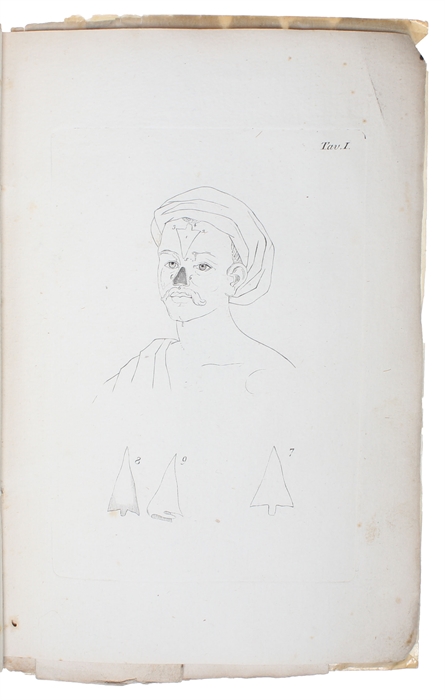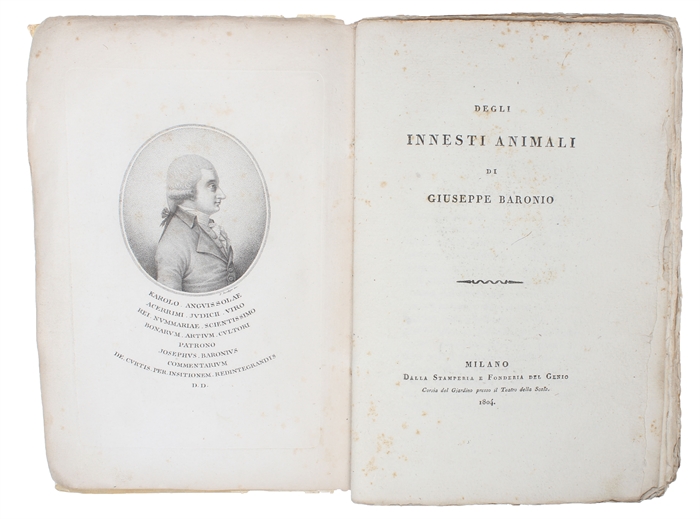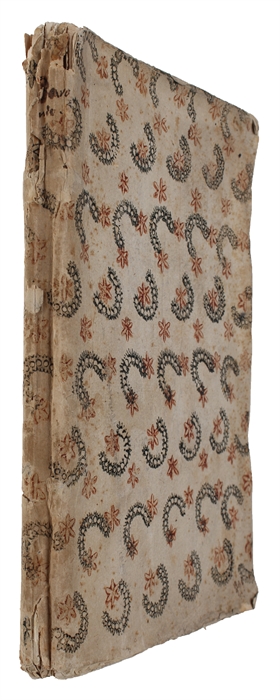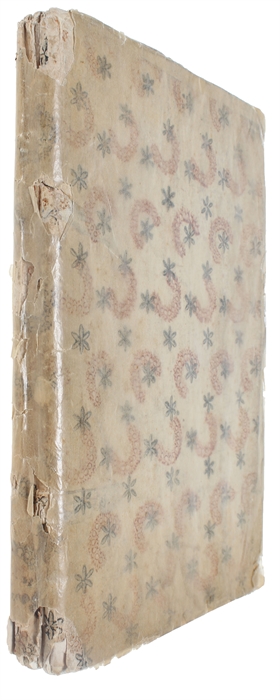THE BEGINNING OF A NEW ERA FOR PLASTIC SURGERY
BARONIO, GUISEPPE.
Degli innesti animali.
Milano, Genio, 1804.
Lex 8vo. Large-paper copy, completely uncut, on extra-thick paper, in the original wrappers of hand-blocked patterned paper. With a few contemporary hand-written annotations/corrections and marginal markings. An extraordinarily fine copy with minimal wear. 78 pp. + 1 f. errata. Frontispiece portrait and two engraved plates (one - with the famous sheep - folded).
A magnificent copy, in completely original condition, of the rare first edition (printed in a small number only) of this milestone in the history of plastic surgery, Baronio's immensely significant masterpiece, which constitutes the first example of purely scientific research in the history of plastic surgery. Furthermore, it is in this work that the possibility of skin transfer (grafting) is demonstrated for the first time, marking the beginning of a new era for plastic surgery. "The basic principle of free transplantation . . . constituted, when fully understood and applied, the greatest single advance [in plastic surgery] of the nineteenth century." (Gnudi & Webster, p 328).
"Degli Innesti Animali, has to be considered an epoch-marking work for several reasons. It is the only treatise on plastic surgery written two centuries after Tagliacozzi's De Curtorum Chirurgia (1597). It is the first experimental account on a successful autologous skin graft in an animal with a detailed report. It is the first example of purely scientific research in the history of plastic surgery." (ISAPS - International Society of aesthetic plastic surgery).
"It is a landmark in the development of plastic surgery procedure after two centuries of neglect." (Hagströmer).
Describing his experiments with skin grafting on animals (most famously on the sheep, which is depicted in the book), Baronio laid the foundation for human skin grafting, which was only successfully done for the first time 13 years later, in 1817.
"Baronio carried out trials on a total of 27 animals (rams, goats, dogs, and even a mare and a cow), always with the same positive results. These studies were of immense significance, serving first and foremost to demonstrate that grafts could be transferred and survive, a fact up to then had not been scientifically proven. Indeed, this possibility was dismissed by leading surgeons including Alfred Armand Velpeau who… asserted that "this strange operation will never be practiced" Furthermore, by comparing the results of grafts carried out under different conditions and different time intervals, Baronio succeeded in clarifying many of the biological aspects of the grafting and healing processes." (Santoni-Rugiu & Sykes: A History of Plastic Surgery, p. 123).
"The publication of "Degli Innesti Animali" (On grafting in Animals) by Giuseppe Baronio (1759-1811) in 1804, the first account of experimental autologous skin transplantation in a ram, marks the beginning of a new era for plastic surgery - the demonstration that skin transfer in the same individual is possible and successful.
Degli Innesti Animali, the most important work of Baronio, is a 78-page book, printed on thick paper, issued in 1804 in Milan by Tipografia del Genio. The book is rare and seldom appears on the market. It is divided into seven parts and includes three engraved illustrations. The first one shows the portrait of the Count Carlo Anguissola, to whom the work is dedicated, who sponsored the publication, although this is not mentioned, and provided animals and stables for making Baronio's experiments possible.
In parts one and two, Baronio traces the origin of nasal reconstruction by quoting the Brancas of Sicily, Tagliacozzi, and the Maratha surgeons from India. The Tagliacozzi's arm flap technique is extensively described, whereas the Indian forehead flap procedure is also illustrated by an engraved plate. Part three is devoted to transplantation of teeth in human beings, a procedure first reported by John Hunter; whereas part four explains the grafting of spur and "other animal parts into the cock's comb." In part five, Baronio reports the method of healing severed skin parts by using certain balms, as proposed by some charlatans. Part six, the most important section of the book, deals with the original Baronio studies on skin graft in a ram. He carried out three types of experiments on the farm of the estate of the Count Anguissola at Albignano, in the surroundings of Milan. In doing this, Baronio was supported by two Milanese surgeons G.B. Monteggia (1762-1815) and G.B. Palletta (1748-1832).
In the first experiment, he excised a piece of skin from the dorsum of a ram and grafted it immediately on the opposite side without suturing it, but attaching it with an adhesive. After eight days the graft took perfectly. In the second experiment, on the same ram, the time lapse was 18 minutes. Baronio noticed that the graft had some difficulties in taking (Author's note: probably superficial necrosis at it occurs in full thickness skin grafts). In the third experiment, always on the same ram, the time lapse was longer and the graft did not take. He concluded that the shorter the time for transplantation the better in terms of survival rate. A beautiful engraved illustration of a ram with skin grafts positioned along its dorsum accompanies the text. Regrettably, Baronio was not aware that the thickness of the skin was the most important factor for skin graft survival. Very possibly in the third experiment he harvested the skin with the underlying adipose tissue, thus jeopardizing the graft take.
In the last part of the book, part seven, he created wounds on different animals (goat, dog, sheep) and covered them with aluminum paste to isolate wounds from the air to avoid potential contamination. He noticed that this method facilitated wound healing.
Degli Innesti Animali, has to be considered an epoch-marking work for several reasons. It is the only treatise on plastic surgery written two centuries after Tagliacozzi's De Curtorum Chirurgia (1597). It is the first experimental account on a successful autologous skin graft in an animal with a detailed report. It is the first example of purely scientific research in the history of plastic surgery. For this reason, the founding members of the Plastic Surgery Research Council established the image of the Baronio ram with skin graft over its dorsum as the emblem of the organization. (ISAPS).
Garrison-Morton 5736; Gnudi & Webster, The Life and Times of Gaspare Tagliacozzi, p 328; Zeis Index 301 & 422; Maltz, Evolution of Plastic Surgery, p 221; Bankoff, The Story of Plastic Surgery, p. 42; Belloni, 'Dalle "Riproduzioni animali" di L. Spallanzani agli "Innesti animali" di G. Baronio' in Physis, III, 1961, pp 37-48; Hirsch, I, 243. Waller 686.
Order-nr.: 52659




